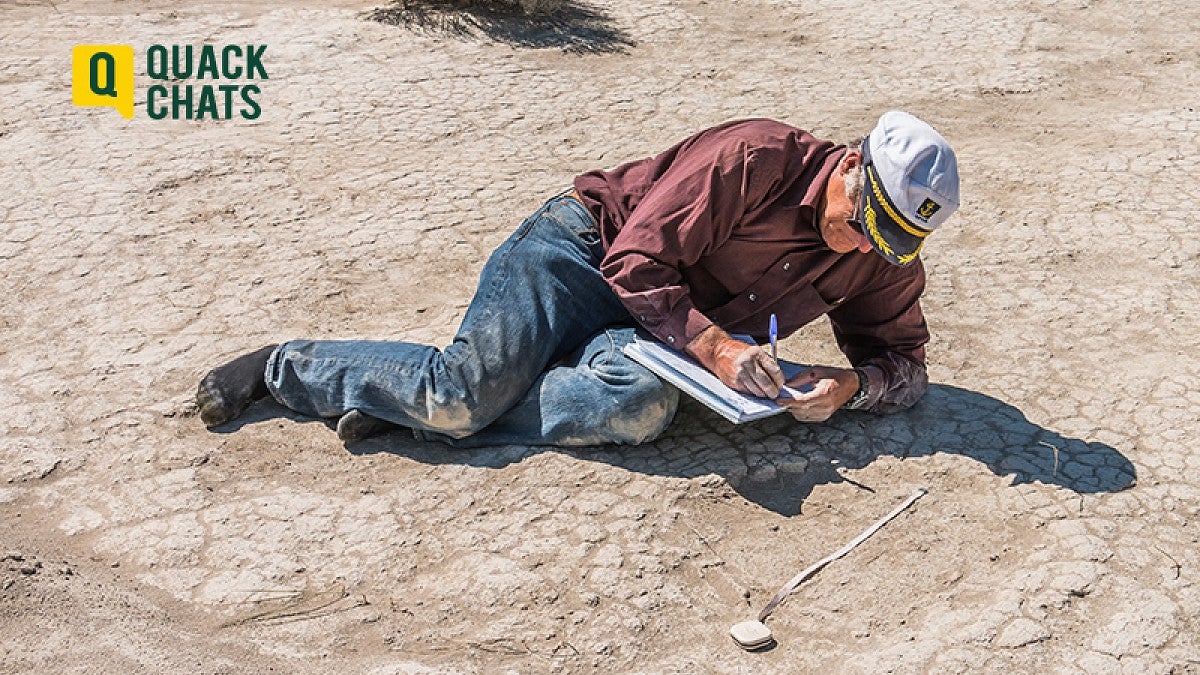Travel back in time as University of Oregon fossil expert Greg Retallack discusses recent discoveries dating back to 103 million and 43,000 years ago during his Feb. 20 Quack Chats pub talk in downtown Eugene.
Think mammoths and dinosaurs. For fossil collectors, the discoveries suggest there are many artifacts still to be found across present-day Oregon.
RELATED LINKS
“Never say never when it comes to finding fossils,” said Retallack, a professor in the Department of Earth Sciences and director of fossil collections at the Museum of Natural and Cultural History. “They will always surprise you. We never thought we would find an Oregon dinosaur.”
Retallack’s Quack Chats talk, “New evidence of dinosaurs and mammoths in Oregon,” will detail what he found and tie it all to the geology and climates that existed in Oregon at the time the creatures roamed the Earth. He may throw in short songs about his discoveries.
The talk will begin at 6 p.m. at the Ax Billy Grill & Sports Bar on the third floor of the Downtown Athletic Club, 999 Willamette St. Admission is free. Food and drinks will be available for purchase.
Retallack was on a field trip near Mitchell, just west of the John Day Fossil Beds National Monument, in 2015 when his group found evidence of a dinosaur. It turned out to be a toe bone of a plant-eating, bipedal dinosaur that had lived during the Cretaceous, a geological period that also gave rise to Tyrannosaurus rex.
Oregon, at the time the dinosaur lived and died, was little more than two volcanic islands – the Blue and Klamath mountain ranges – rising above the ocean. The region was being pushed up against the North American Plate, extending the shoreline westward from near Idaho.
Retallack also will discuss the 1969 discovery by a group that included former UO researcher Dave Taylor of a dinosaur bone near Cape Sebastian State Park near Oregon’s southern coast. That bone turned out to be the sacrum, or fused vertebrae located at the foot of the spine, of a duckbilled hadrosaur.
Retallack and Taylor, now president of the Northwest Museum of Natural History, coincidentally published their findings at about the same time late last year.
“Suddenly, we had two Oregon dinosaurs,” Retallack said. “Wasn’t that awesome?”
On another field trip in 2014 on Lake County, Retallack noticed “funny round depressions in the ground, mostly volcanic tuff, that were filled with a gray matrix.”
With permits and a small grant, Retallack’s team and a crew from the Bureau of Land Management returned to the site. They excavated about 20 meters of a trackway that is possibly 10 kilometers long. They identified 117 impressions thought to be footprints of adult, juvenile and infant mammoths. It appeared that juveniles may have been interacting with a limping adult female.
“I had no idea what we would find, but it turned out to be really stunning,” Retallack said. “We had this trail, where we could tell that a large female and little babies had been moving about.”
Quack Chats is a program of University Communications. For more information, see the Quack Chats section on Around the O. A general description of Quack Chats and a calendar of additional Quack Chats and associated public events also can be found on the UO’s Quack Chats website.
—By Jim Barlow, University Communications


